SUMMER 2013 CONTENTS
Home
Hiding in plain sight
The environmental factor
Priming the pumps
Debugging Dhaka’s water
Close encounters
How we're crossing paths with disease-bearing pests
Street smarts
Using citizen-scientists to fight for healthier neighborhoods
Beyond hurricane heroics
What Sandy should teach us all about preparedness

DOWNLOAD PRINTABLE
ISSUE (PDF)


Special Report
Beyond hurricane heroics
What Sandy should teach us all about preparedness
Story and Photography by Sheri Fink
Inside the Seaview Manor Home For Adults in Far Rockaway, Queens, on Oct. 30, 2012, as the home prepared to evacuate its 124 residents.
On Oct. 29 last year, Laura Evans, MD, medical director of critical care at Bellevue Hospital Center in New York City, the nation’s oldest public hospital, was called to the hospital’s emergency command center. A storm surge, a giant wall of water forced up from the East River by Hurricane Sandy, was predicted to smack into land surrounding the hospital.
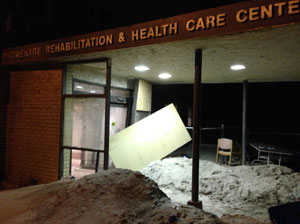
Sand-filled entryway of Promenade Rehabilitation & Health Center in Rockaway Park, Queens, after Sandy.
Flooding could, hospital leaders told Evans, disable the pumps that delivered oxygen and vacuum suction to the hospital as well as those that supplied the fuel from underground tanks to its backup generators.
The loss of the fuel pumps would mean that backup power would last only as long as the fuel lasted in small day tanks attached to the generators located on the hospital’s 13th floor. If city power failed during the storm, the fuel in the generators’ day tanks would be exhausted within two hours.
Nearly all of the patients in Evans’ 56-bed adult intensive care unit relied on equipment that ran on electricity. Many were on life support, or had intravenous drips that regulated their heartbeats and blood pressure. Some had intra-aortic balloon pumps that helped keep their blood flowing. “It was really terrifying,” Evans says.
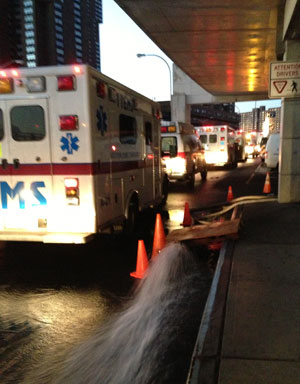
Water gushes out of a pump at Bellevue as ambulances idle and wait for patients during the evacuation on Nov. 1.
The command team had limited good news. They believed the generator in the building next door, supplied by a separate fuel pump, would continue functioning. They could use it to power exactly six outlets in the intensive care unit. Hospital leaders turned to Evans. They would continue looking for a way to keep all vital equipment powered — but if they failed, which of her very sick patients should be given access to one of the precious six power outlets?
“Laura,” one hospital official said, “we need a list.”
Professionals, patients and their loved ones in New York City hospitals, nursing homes and adult-care facilities might reasonably have believed they were safe as Hurricane Sandy approached. While many of the facilities sat beside tidal rivers and the ocean in low-lying “Zone A” areas of the city, Mayor Michael Bloomberg had exempted them from his pre-storm evacuation order for the general population. They could, instead, “shelter in place.”
But anyone following the recent history of how hospitals and nursing homes have fared in American disasters had ample reason for concern. The images of the hurricane spinning toward my city, and the knowledge that thousands of New York’s most fragile residents would be left in its path, in facilities that were not hardened to withstand significant flooding or power outages, made my stomach sink.
In many New Orleans hospitals after Hurricane Katrina in 2005, floodwaters knocked out vulnerable backup power systems. A day later, still awaiting rescue in intense summer heat, doctors at Memorial Medical Center were so desperate, they intentionally hastened the deaths of some patients by injecting them with morphine and midazolam, one or both detected in at least 18 of the 45 bodies ultimately found at the hospital.
Over the past five years, I’ve reported on the impact of disasters on hospitals and medical systems, from Hurricanes Katrina, Gustav and Isaac in New Orleans to Tropical Storm Irene in New York. I’ve just written a book about this subject, Five Days at Memorial: Life and Death in a Storm Ravaged Hospital (Crown) — due out this September. When Hurricane Sandy approached, I reported from New York City’s hospitals and nursing homes. One question stuck with me: After everything we’ve learned about those horrific days in New Orleans, how could other hospitals in a major American city end up without power, their workers fighting to keep alive their most desperately sick patients?
I came away with the firm belief that America’s medical infrastructure remains extremely vulnerable to natural hazards, and there is an urgent need for disaster planners to involve the larger community in deciding how resources are allocated — both in preparing for disasters and in responding to extreme triage scenarios like the ones faced by Evans and by the physicians who served after Hurricane Katrina.
Lessons from the last battle?
The health commissioners for New York state and New York City are hands-on leaders with substantial experience. City health commissioner Thomas Farley, MD, was working in New Orleans at Tulane University at the time of Hurricane Katrina. New York state’s commissioner of health Nirav Shah, MD, based himself with the team at New York City’s emergency operations center.
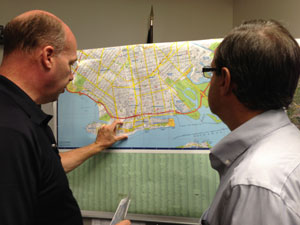
Scott Strauss, North Shore-LIJ Health System’s director of corporate security and emergency management, left, and Mark Solazzo, chief operating officer, at the health system’s command center, Oct. 30, 2012.
Before Tropical Storm Irene struck in 2011, Farley and Shah helped oversee the transfer of roughly 10,000 patients from seven New York City acute-care hospitals and 39 nursing, psychiatric and adult-care homes in partnership with the city agencies and public and private medical organizations.
“We were not confident any could withstand flooding on the first floor without a loss of power and an inability for them to be rescued quickly,” Farley told me at the time, in September 2011. “Our assessment was it was safer for them to evacuate than stay in place.”
Shah’s stance was similar. “It was the right decision,” he told me just after the 2011 storm passed, even though the health facilities did not end up flooding and the move turned out not to have been necessary. “Imagine what would have happened if there was an 8-foot surge? All those places would have been under water and would have been really on little islands right now.”
How could other hospitals in a major American city find their workers fighting to keep alive their most desperately sick patients?
As Sandy was churning up the coast, I asked both men why a different decision was being made, with the storm surge expected to be even higher. Health officials elsewhere in New York and in other states mandated that patients be moved away from the water. Shah said he felt confident that if anything should go wrong, the city was ready to respond quickly. The commissioner of the city’s Office of Emergency Management, Joseph Bruno, sounded similarly sanguine. “I’m very confident in the way it’s been handled,” he said.
The officials had instructed vulnerable nursing homes to move residents to higher floors and to transfer roughly 100 residents who required mechanical ventilators to help them breathe. The state also ordered nursing homes to staff their facilities at more than 50 percent higher than usual. Health and emergency officials surveyed the facilities before the storm “to eyeball generators,” watch them be turned on, and assess fuel and food supplies, Shah said.
However, they did not check whether the generators were vulnerable or protected against the floodwaters that might be unleashed by a storm surge. And they did not advise evacuation for any of the dozens of facilities where, state databases show, deficiencies had been noted in nursing home backup generators, wiring, maintenance and preparedness measures, including evacuation plans.
Shah pointed to the substantial risks involved in pre-storm evacuations for vulnerable patients. “It’s extremely agitating,” he said. “We learned there’s a risk-benefit of moving people versus sheltering in place.”
It’s true there have been fatalities in pre-storm evacuations. A bus carrying nursing home residents away from Houston in advance of Hurricane Rita in 2005 overheated and burst into flames, igniting oxygen tanks and killing 23 people. When New Orleans implemented citywide hospital and nursing home evacuations prior to Hurricane Gustav in 2008, many patients were transferred to Baton Rouge, which was harder hit by power outages from the storm, necessitating the re-transfer of a number of patients. More research needs to be done on the health effects of evacuation, particularly comparing those transferred in a controlled way prior to a storm and power loss, versus those moved in the chaotic midst of a disaster.
Some observers suspected another factor might have been considered. It is expensive for hospitals and nursing homes to shut their doors proactively. New York City health-care facilities were, at the time of Sandy’s approach, awaiting reimbursements in the millions of dollars for the ultimately unnecessary evacuations the city and state had mandated before Irene. The thought that this could occur again was, at the least, an unpleasant one. Shah said financial considerations played no part in the evacuation decision-making.
The impact
Three major hospitals in New York City lost power and had to be evacuated during or after the storm, including Bellevue and Coney Island hospitals, both run by the city, and the private New York University Langone Medical Center. The Veterans Affairs New York Harbor Healthcare System evacuated in an orderly fashion before the storm arrived.
At least 29 nursing and adult-care facilities in Queens and Brooklyn were severely flooded. Generators failed or were absent. At Horizon Care Center in Arverne, near the Atlantic Ocean, the water rose to knee height on the first floor within a span of five minutes, according to administrator Nicole Markowitz. The backup generator worked for only about 10 minutes after the power failed. Overnight, it was hard to change patient diapers in the dark. The next morning, elderly residents sat in chairs in chilly, dim, foul-smelling hallways.
In all, more than 4,000 nursing home and 1,500 adult home residents in New York City endured up to three days in cold, dark surroundings before being rescued, often hauled down staircases on disaster sleds carried by first responders.
The long-term health effects on vulnerable patients remain to be calculated. Officials have not examined whether the death rate increased in residents who scattered across the region. One member of a team of researchers who wish to study these issues said this spring that she had not yet been given access to needed data by state officials.
Making sense of the decisions
“It’s worth looking at what would be the costs and advantages of making hospitals a little more capable of withstanding a flood of a certain height,” Commissioner Farley told me after Tropical Storm Irene. But it took until June 2013 for the city to release a comprehensive plan to protect health infrastructure — part of a $20 billion proposal to prepare New York for future storms — and most improvements would not need to be in place until 2030.
Hospital backup generator system standards are more oriented to short-term power losses. There is no dress rehearsal for days-long outages.
The question is: Who pays to harden the systems? Many hospitals were built years ago to different building codes and then expanded with additions. Hospital wiring diagrams I’ve reviewed in Katrina hospital-liability cases look like masses of spaghetti.
Raising generators above flood level is just the first step in protecting a hospital’s backup power. Often, transfer switches and other elements of the electrical systems and fuel and water pumps need to be moved or made submersible as well.
Some say flood-proofing these systems should be considered public investments. Others argue it is unreasonable to expect hospitals to gird against all foreseeable, but unlikely, catastrophes.
Ironically, only now is the New York City Health and Hospital Corp. eligible to receive substantial federal funding to make those improvements to its disaster-struck hospitals and health-care facilities. According to corporation president Alan Aviles, the costs of repair and improvements will exceed $800 million — much higher, presumably, than the cost of prevention.
Perhaps hospital accreditation standards and electrical codes should also be tightened. Currently, hospital backup generator system codes and standards are more oriented to short-term power losses like those that might occur when a tree branch falls and cuts off city power for a few hours. Generators must be tested under load for only short periods. There is no dress rehearsal for the days-long outages that are likely to follow a severe disaster like a hurricane. Often it takes a real crisis for hospital engineers to discover problems — for example, difficulty switching back from generator load to city electricity.
Even if backup systems ran for longer periods, at many hospitals, they are not designed to power critical functions, particularly heat, air conditioning and ventilation. Hospital standards do not require this and are “not always sufficient” in major catastrophes, according to a post-Katrina warning issued by the largest hospital accreditation body, the Joint Commission.
Nor is there a standard for how the flow of information is to be handled. In New York there was no central place for relatives of hospital patients and nursing home residents to find out where their loved ones were or whether they were safe. Many endured a prolonged, tortured limbo.
Doing better
At a Hurricane Sandy medical meeting sponsored by the Institute of Medicine and the New York Academy of Medicine in April, many speakers noted the ingenuity, hard work and willingness to endure hardship on the part of the city’s medical professionals. “The amount of heroism that arises during situations like this cannot be overstated,” Irwin Redlener, MD, head of the National Center for Disaster Preparedness at Columbia University, said.
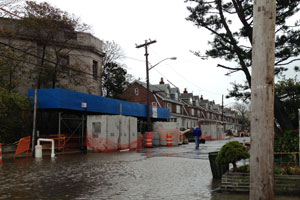
A street in the Rockaways, Oct. 30.
But Redlener saw a problem with that. “We need to wonder why we needed so much heroism,” he said.
From my observations of multiple disasters, health system preparedness needs to occur on multiple levels: the physical, organizational and personal. This might involve investing in infrastructure improvements, purchasing a stock of emergency ventilators, or planning for alternate care spaces where patients can quickly be moved and treated. It can mean looking at what disposable equipment can be reused in an emergency, making sure there are redundant communications for when the cell phone towers go down, and having contingency plans for reaching home-based patients and stocking them with everything they might need before a crisis.
Preparedness might include setting up a quiet space and a schedule of sleeping shifts and insisting that staff members get enough rest to be able to function. Plans are needed to ensure that even when the very fundamental technologies fail, the medical staff maintains the rhythm of patient care, the best possible sense of normalcy in a most abnormal situation.
Above all, a good response requires flexibility and situational awareness: making sure actions match up with the actual conditions, not just the plan.
Thinking creatively
As Sandy intensified outside of Bellevue Hospital, Laura Evans, the critical care medical director, brought news of the expected power outage back to her ICU staff. Choices had to be made about which patients would have access to the six power outlets that might keep working even if every other outlet died. Evans had studied New York state draft guidelines on how to allocate ventilators in a severe respiratory pandemic using a scoring system that estimates how severely ill someone is. She repurposed these plans to help guide the decision-making.
Evans pulled together an ad hoc committee to make the choices. “This isn’t a role for one person,” Evans told hospital leaders. Her committee was composed of professionals who had no patients that would be affected by the decisions. In this way, direct providers would be free to do what their ethical duty required. “If you’re the primary doctor,” Evans says, “it’s your job to advocate for your patient.” The committee, by contrast, could take a wider range of factors into account and choose fairly according to transparent scoring guidelines. The committee included not only doctors, but also ethicists and nurses. It did not, however, include representatives of patients or their families.
The decisions about the power outlets and the reasons for them were communicated to fellow providers. Some challenged the choices, but in the end they accepted them. All of this was accomplished — a list of patients, moving them between beds — within about two hours.
As she prepared the plan, Evans thought about how she would feel the next day if it had to be implemented. She wanted, she said, to “have a process that we can describe, that is transparent,” that was applied to all patients the same way, “as fair and equitable as it can be.” She wanted to look back and be able to justify the decisions they were making, to maintain the trust of the larger society that might examine them. Medical professionals are used to the illusion of control, she said, and “having a system and procedures gave us a sense we had some control of the situation.”
That night, as Evans and her colleagues were completing their list, the lights flicked out. City utility power had failed. It took about seven terrifying seconds for power from the backup generators to kick in and get things functioning again. Soon after, Evans received a call from the hospital’s command center. Except for those six outlets, all power would be lost in the next hour to 90 minutes, hospital leaders believed. Millions of gallons of floodwaters were filling the basement of the 25-story hospital to what would reportedly reach a height of more than 4 feet and more than double that in some areas. Water gushed into elevator pits with enough force to remove elevator doors from their moorings.
Evans and her colleagues stationed two health professionals at the bedsides of all patients who relied on ventilators, preparing to squeeze oxygen into their lungs manually with flexible Ambu-bags. Bright orange extension cords connected to the backup generator system snaked through patient corridors. Nurses counted drops on IV pumps, so that if everything failed, they could go “old school” and give vasopressors by drops per minute.
At several hospitals across the city, doctors and other staff were scrambling, too, contemplating and preparing for the possibility of a complete power outage — a scenario that they had not, in some cases, fully anticipated in previous disaster drills and plans. At the emergency command center for the North Shore-Long Island Jewish Health System, doctors took to a white board to sketch out clinical priorities (“cohort patients,” “establish clinical command structure,” “triage”) for two threatened hospitals as waters rose around them.
At Bellevue, communicating about the triage decisions with patients and their family members was the most challenging aspect of the scenario, Evans said. She and her colleagues could not imagine how to inform those who would not get power outlets, and they put off the task. Looking back, Evans feels the families had a right to know. Preparing for such communication is a high priority for the future. Rarely do triage protocols or standards of care offer guidance on how and whether to inform viable, aware patients or the family members of patients who are triaged not to receive potentially life-sustaining resources. Also, the staff did not think about asking whether any of the selected patients or their families might wish to volunteer to give up a power outlet so that it could be provided to someone else. “It wasn’t even on my radar,” Evans says.
Evans wanted to look back and be able to justify the decisions, to maintain the trust of the larger society that might examine them.
Some guidance does exist on questions of resource allocation in disasters, now commonly called “crisis standards of care.” These are guidelines that lay out which patients should — and should not — receive hospital resources that are in short supply in an emergency.
For example, should the most ill be prioritized, because they are more dependent on medical technology? Or should the less seriously ill patients be prioritized? They could arguably endure more hardship, but they might have better survival chances, making saving them a more efficient way of doing good. What about neonatal intensive care unit babies who are fragile and have, if they survive, a whole life ahead of them? Or the elderly with multiple medical problems and poor prognoses, but who were the wise family matriarchs and patriarchs who inform and inspire, who have served others throughout their lives?
What of medical professionals themselves who may be exposed to higher risks and whose work may be so needed after a disaster? Should they be prioritized? What about support staff? What about hospital supply delivery truck drivers? Where to draw the line?
Clearly these are questions of values as much as they are of medicine. Disaster planners are increasingly realizing that the larger community must be involved in answering them — as an example, in 2012 the Institute of Medicine released extensive community planning guidance for engaging the public in the development of crisis standards of care. Some existing protocols even call for removing patients from ventilators if they do not improve after a certain trial period when ventilators are in extremely short supply. But there hasn’t been much research on this. Based on data from recent flu seasons, a few small studies have found that most patients who would have been assigned a lower triage priority if the protocols had been implemented actually recovered and survived when they received full treatment. In other words, there was slim if any evidence that the traumatic prospect of taking away ventilators or other resources from patients with a lower triage priority actually would have saved more lives.
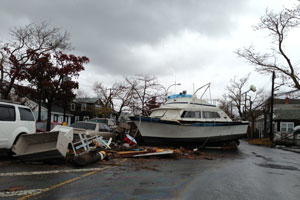
A grounded boat on Cross Bay Blvd. in Broad Channel, Queens.
Sometimes the most important aspect of triage is remaining alert to the possibility that rationing won’t be necessary, or can be minimized — doing everything possible to avoid the need to make such wrenching decisions. In the end, it was improvisation that made the biggest difference at Bellevue after the generator fuel pumps failed. Volunteers, soon replaced by National Guard soldiers, formed a chain and hand-carried fuel up 13 flights of stairs to feed the generators manually until everyone could be transferred out of the hospital. Swift thinking prevented the backup power from failing. It prevented those horrible choices from having to be made. Evans’ patients were all maintained on backup power until they were transferred to other hospitals.
Hours later, climbing one of Bellevue’s long staircases, I passed personnel in blue scrubs carrying a baby in a transport incubator down to a waiting ambulance. Other staff huffed and puffed up the steps with supplies. The smell of diesel wafted into patient corridors. The situation balanced just on the edge of control. Fortunately, dramatic scenes like this do not occur often. But being in New York for Sandy was a reminder that disasters can arise anywhere, at any time, and that they can change the lives of medical professionals, their patients and their families forever. Across the country many hospitals in flood zones have electrical backup power systems in their basements. Others, in earthquake zones, were constructed before modern building codes. Others are simply situated in tornado alley. We need to think more about the dilemmas we might face and how we can prevent or minimize them. It benefits everyone to prepare.
Photograph by
Jen Dessinger
Sheri Fink, MD, PhD, a graduate of Stanford’s School of Medicine, won a 2010 Pulitzer Prize in Investigative Reporting for her story The Deadly Choices at Memorial (co-published by The New York Times and ProPublica) about decisions made by the medical staff of a New Orleans hospital in Hurricane Katrina’s aftermath. Her forthcoming book is Five Days at Memorial: Life and Death in a Storm-Ravaged Hospital (Crown, 2013).
An earlier version of this story appeared on ProPublica: “In Hurricane’s Wake, Decisions Not to Evacuate Hospitals Raise Questions,” Nov. 1, 2012.
Contact Sheri Fink. Follow her on Twitter.

